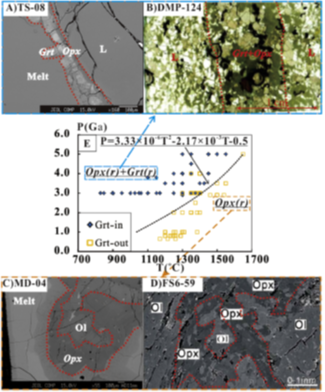2018年12月7日,我院教师王明梁博士、臧春娟博士在Lithos上在线发表了题为“The effect of P–T on the reaction between tonalitic melt and mantle lherzolite at 2–4 GPa and implications for evolution of North China Cratonic Lithosphere and generation of High Mg andesite”的研究论文。
论文摘要:To assess the effects of reaction factors (mainly P and T) on the mineral assemblage and chemical composition of residual minerals and reacted melt in the reaction between andesitic melt and mantle peridotite, we conducted experimental reactions between tonalitic melt and mantle lherzolite using a DS-3600 six-anvil apparatus at 2–4 GPa and 1250°C–1400°C. The reaction products contain two types of reaction vein: orthopyroxene(r) [r means this mineral generated in melt-peridotite reaction and located at reaction rim] + garnet(r) and orthopyroxene(r). The mineral assemblages of the reaction veins are controlled by the reaction P and T, which can be determined via the empirical discriminant function: Y = 3.33 × 10−6T2 − 2.17 × 10−3T − 0.5 − P (T in °C, P in GPa; Y ≥ 0: Opx veins form; Y < 0: Opx + Grt veins form). These two types of reaction vein match those found in mantle xenoliths in Mesozoic and Cenozoic magmas from the North China Craton (NCC), indicating that they were formed by similar processes. The melt–peridotite reaction (including P and T) also influences the chemical composition of the residual minerals in the experimental products, with the major element variations being similar to those of NCC lithospheric mantle evolution from Palaeozoic to Cenozoic. Based on the experimental results, olivine in xenoliths from depths of ~100 km (~3 GPa) has higher SiO2 and lower NiO and MnO contents than olivine in xenoliths from depths of ~130 km (~4 GPa), and orthopyroxene in xenoliths from depths of ~100 km has higher Mg#, higher CaO content, and lower NiO content than orthopyroxene in xenoliths from depths of ~130 km. The reacted-mantle xenoliths contain clinopyroxene that originated from cold (<1300°C) and deep (~135 km) lithospheric mantle. The P–T conditions also control the chemical composition of the reacted melt. An increasing reaction pressure increases the SiO2 content, whereas an increasing reaction temperature reduces the SiO2 content. In combination with the varying Na2O and K2O contents of the parental magma, the reacted melt can yield almost all types of intermediate magma with high Mg# (Mg# = mol[Mg/(Mg + ∑Fe)], Mg# > 0.45) character. This variation in major element of the reacted melt agrees with field observations of Mesozoic high-Mg# andesitic rocks from the NCC, indicating similar causes of the variation in the major element contents. With respect to the trace element content of the reacted melt, a garnet content of 15%–20% produces a right deviation of the heavy rare earth element partition curve (chondrite-normalized) and substantially elevates the Sr/Y and LaN/YbN ratios, indicating an adakite-like reacted melt.
